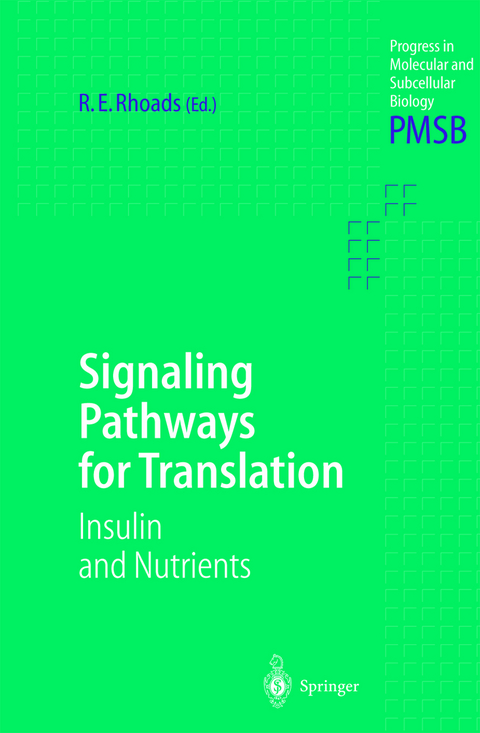
Signaling Pathways for Translation
Springer Berlin (Verlag)
978-3-642-62589-3 (ISBN)
Insulin Signaling and the Control of PHAS-I Phosphorylation.- 1 Introduction.- 2 Mechanism of Translational Repression.- 3 PHAS Isoforms.- 4 Phosphorylation Sites in PHAS-I.- 5 Protein Kinases That Phosphorylate PHAS-I in Vitro.- 6 Control by Hormones, Nutrients, and cAMP.- References.- Insulin, Phorbol Ester and Serum Regulate the Elongation Phase of Protein Synthesis.- 1 Introduction.- 2 Structure and Function of EF-1 and EF-2.- 3 Modifications of EF-1 and EF-2.- 4 Regulation of Elongation by Insulin Via Multipotential S6 Kinase and EF-2 Kinase.- 5 Regulation of Elongation by Phorbol Ester Via Protein Kinase C.- 6 Regulation of Elongation during the Cell Cycle by Cdc2.- 7 Lack of Regulation of Elongation by Protein Kinase Casein Kinase II.- 8 Conclusions.- References.- Regulation of Protein Synthesis by Insulin Through IRS-1.- 1 Introduction.- 2 Materials and Methods.- 3 Results.- 4 Discussion.- References.- Regulation of Eukaryotic Initiation Factor eIF2B.- 1 Function and Structure of eIF2B.- 2 eIF2B Activity Can Be Regulated by the Phosphorylation of eIF2?.- 3 Regulation of eIF2B Activity in Vivo.- 4 Mechanisms Involved in the "Direct" Regulation of eIF2B Activity.- 5 Other Phosphorylation Sites in eIF2B.- 6 Other Inputs into the Control of eIF2B.- 7 Conclusions and Perspectives.- References.- The p70 S6 Kinase Integrates Nutrient and Growth Signals to Control Translational Capacity.- 1 Identification of the p70 S6 Kinase.- 2 Expression and Structure.- 3 Substrate Specificity and Selection.- 4 Cellular Function(s).- 5 Regulation of the p70 S6 Kinase.- 6 TOR Regulates Cell Function in Response to the Nutrient Milieu.- 7 p70 is Regulated by Multisite (Ser/Thr) Phosphorylation.- 8 RTK Recruitment of Type 1A PI-3 Kinases Activates p70 S6 Kinase.- 9 The Mechanism ofp70 Activation by PI-3 Kinase and the Role of PDK1.- 10 Candidate "p70 Thr412 Kinases".- 11 Conclusion.- References.- Regulation of Translation Initiation by Amino Acids in Eukaryotic Cells.- 1 Introduction.- 2 Regulation by Amino Acids of met-tRNAi Binding to 40 S Ribosomal Subunits.- 3 Regulation of mRNA Binding to 40 S Ribosomal Subunits by Amino Acids.- 4 Is There Coordinated Regulation by Amino Acids of Translation Initiation and Elongation?.- 5 Summary.- References.
| Erscheint lt. Verlag | 30.10.2012 |
|---|---|
| Reihe/Serie | Progress in Molecular and Subcellular Biology |
| Zusatzinfo | X, 186 p. |
| Verlagsort | Berlin |
| Sprache | englisch |
| Maße | 155 x 235 mm |
| Gewicht | 311 g |
| Themenwelt | Naturwissenschaften ► Biologie ► Biochemie |
| Naturwissenschaften ► Biologie ► Mikrobiologie / Immunologie | |
| Naturwissenschaften ► Biologie ► Zellbiologie | |
| Schlagworte | Amino acid • Amino Acids • Aminosäuren • Cellular growth • elongation factors • Elongationsfaktoren • growth • Hormone • Insulin • phosphorylation • Protein • Proteinsynthese • Protein synthesis • Regulation • Ribosomen • Ribosomes • Säure • signaling pathways • signal transduction • synthesis • Translation |
| ISBN-10 | 3-642-62589-4 / 3642625894 |
| ISBN-13 | 978-3-642-62589-3 / 9783642625893 |
| Zustand | Neuware |
| Haben Sie eine Frage zum Produkt? |
aus dem Bereich


